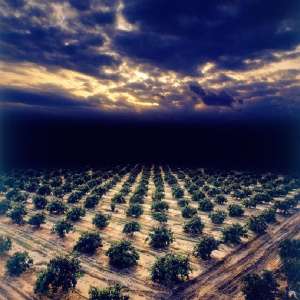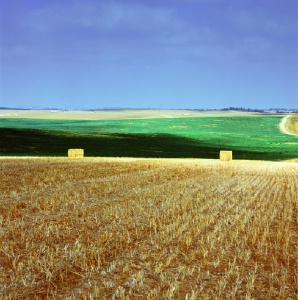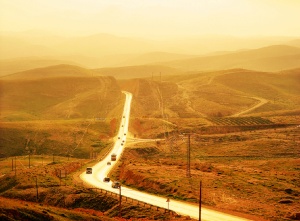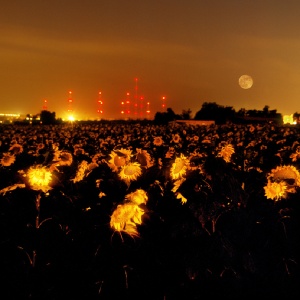Marking the Land of Israel:
Photographs of Chanan Getraide
What makes the Land of Israel so special? Given to us by God this wonderfully diverse corner of earth is much more of a “gift” than meets the eye. It is a gift that carries responsibility as an inheritance to be treasured even as it is trod upon, marked, possessed and inhabited by the Jewish people. The real meaning in the gift of the Land of Israel is in how the Jews use it. In the utility of the Holy Land we will become a holy people. The extraordinary photographs of Chanan Getraide in the Promised Land currently at the Hebrew Union College Museum evoke the material reality of the Jewish people on their Land.
These eighteen large scale (30 x 40) color photographs are initially seen as handsome landscape images that employ the natural light and vivid contrasts that are commonplace in Israel. Light yellow straw, green, and ochre fields provide a patterned foundation for the austere presence of two bales of wheat in the fertile Negev. In another image the Sinai desert mountains appear burnt and volcanic as they meet the pale dry sands near the fence and road of the Egyptian-Israeli border. Far to the north the Kinneret spreads its rich blue surface to the top of the frame as the foreground is accented with the brilliant green hills of the Galilee. Two white boats appear to meet far in the distance. The natural beauty of Israel seems to be the photographer’s primary subject. Then the viewer notices something is awry.
The enlarged photographs emphasize a paradoxical flatness of color and tonal evenness across the picture plane, driving many of the images to the edge of abstraction. The compositions are carefully considered balances between areas of brilliant color and muted shapes of tonal richness. Upon close inspection each image has a pictorial tale to tell.

The Orange Grove on Kibbutz Shiller (the photographer’s home and birthplace) is a dichotomous treatise on the partnership between God and man. In the lower half the trees are planted in neat rows emphasized by the diagonal perspective that creates another illusory set of rows. The chevron shaped band of light breaking through the blue-purple clouds above reflect the earth bound trees even as the clouds swirl turbulently in a kind of Divine apotheosis. Getraide’s image goes beyond simple juxtaposition by emphasizing the deep purple shadow that divides the heavens from the orange grove. It is as if both halves of the photograph desperately need one another and yet can never actually touch, much as Divine sustenance of the Land of Israel is in the form of the distant blessing of rain, its source untouchable and yet essential. Man plants and God waters.
Water is also the subject of Dead Sea Canal as the preternaturally blue Dead Sea waters are siphoned off in a graceful canal that slices through the barren landscape. Electric lines echo the imposition of man’s needs on this primitive and ancient landscape. It was this image that revealed to me the photographer’s insight in most of these works.
Looking at the stark landscape I wondered why it did not seem defiled by the human intrusion, in fact, why it looked so natural for Israel. I then realized that it was exactly this human intrusion that fulfilled the purpose of the Land of Israel to be a fruitful homeland for the Jewish people. For God’s gift to be fulfilled the Land had to be worked, possessed, and marked by the conscious efforts of the Jewish people.

The Wheat Field with Two Bales, Negev suddenly lost its natural allure as the abstract symmetry caused by the cube-shaped bales balanced between the thin horizon and the sunlit median imposed a strict order on the fields. Every element in this picture depicts the strenuous efforts of cultivation, a desert land commanded to produce by a determined people.

Another deeply abstract image, Jerusalem to Jericho Road, emphasizes a radical marking of the Israeli landscape. The glaring white pavement curves from the foreground into a straight incision that cuts through the tranquil hills. The surrounding gentle wilderness of soft ochres, browns and earth reds fades into the haze covered hills; a tonal testament to permanence until one notices up close that the land itself is covered with the subtle and inexorable marks of man. Life-giving power lines parallel both sides of the road, a rectangle of cultivation contrasts with a distant flock of sheep while advertisements to buy, settle and live on the land dot the roadside. A similar image, Road with a Single Car near Jericho, even more dramatically depicts a road slicing through a brilliantly lit ochre colored hill, its black asphalt linking with the impending night sky threatening at the top of the image.
Chanan Getraide’s intimate knowledge of the land and considerable technical skill at making images cannot account for these visual insights. Rather it is an intuitive understanding that the Israeli landscape is different than other beautiful natural motifs in some fundamental way. Curator Laura Kruger, in her selection and exhibition of the prints, has shaped his work to accentuate this quality. Image after image proclaims that the intrusions of cultivation, roads, water works, electrical lines and housing upon an awesome natural landscape actually enhances the Land of Israel, fulfilling its promise as an inheritance to the Jewish People.

Sunflowers at Night is perhaps one of the most moving images in the exhibition. A field of sunflowers mysteriously lit from an unknown source supports an equally surreal horizon. The towers of an oil refinery or chemical plant, lit with red warning lights, pierce the night sky adjacent to the full moon suspended low in the hazy atmosphere. In this image of nature transformed, the sunflowers symbolically operate as both a surrogate sun and as a metaphor for the fecundity of its seeds. But such natural phenomena are never far from the Israeli industry that the nation depends on. The nation of Israel, subject to the waxing and waning of its fortunes is represented here as the full moon. It is hard to imagine a more unnatural image that connects as vividly with the very essence of Israeli landscape.
These creative and provocative images of Chanan Getraide are a singular expression of the Covenant of the Land that is a central prospect of the Jewish people. God’s gift becomes an inheritance. And through that inheritance, working, inhabiting and marking the Land, we become partners with God as a Holy People in a Holy Land.
The Promised Land: Photographs by Chanan Getraide
Hebrew Union Collage – Jewish Institute of Religion Museum
One West 4th Street, New York, NY